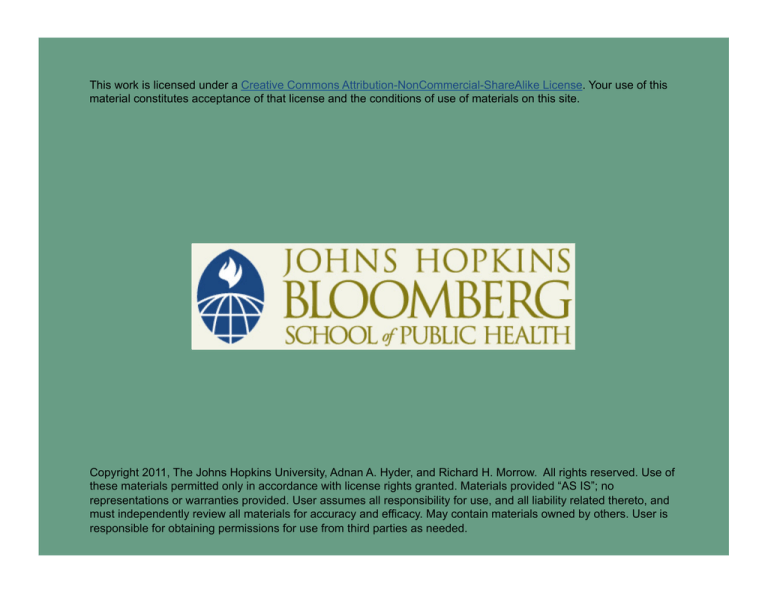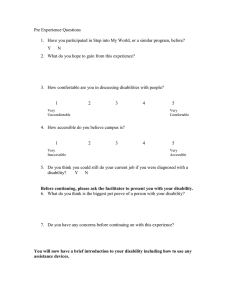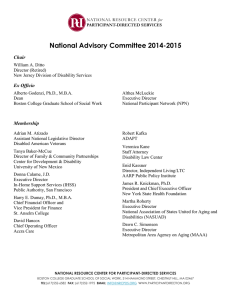
This work is licensed under a Creative Commons Attribution-NonCommercial-ShareAlike License. Your use of this
material constitutes acceptance of that license and the conditions of use of materials on this site.
Copyright 2011, The Johns Hopkins University, Adnan A. Hyder, and Richard H. Morrow. All rights reserved. Use of
these materials permitted only in accordance with license rights granted. Materials provided “AS IS”; no
representations or warranties provided. User assumes all responsibility for use, and all liability related thereto, and
must independently review all materials for accuracy and efficacy. May contain materials owned by others. User is
responsible for obtaining permissions for use from third parties as needed.
Section B: Days of Life Lost: Grandfather of DALYs
Adnan A. Hyder, MD, PhD, MPH
Days of Life (DLL)
Approach of the Ghana Health Assessment Team (1976–1981)
Forms foundation of the HeaLY/DALY approach
The DLL index based on estimation of incidence, case fatality, case
disability, average age of onset, duration, and local expectation of
life
Summed over the whole population and based on rates per 1,000
population
3
DLL: Elements 1
Local Ghana life tables were used to determine the potential at
each age
Morbidity was added
Estimation of disability done nationally using community and expert
opinion
Each year of life was valued equally
Discounting of the future stream of losses done at 3% per annum
4
DLL: Elements 2
Division of disability into temporary, permanent, and that prior to
death
-
These categories introduces a level of detail that was difficult
to support with valid data at that time
Based on clinical approach of disease onset and prospective view
Date mostly institution based in Ghana
5
Disability Adjusted Life Years (DALYs)
First introduction
6
Disability Adjusted Life Years
Loss from premature deaths is assessed by evaluating deaths in a
year—years of life lost (YLLs)
Life lost from disability is estimated using years of life lived with
disability (YLD)
The combination of YLLs and YLDs gives DALYs
Originally a single equation was used to incorporate all technical
and value choices
7
DALYs 2
DALY calculation uses the age distribution of deaths by cause for a
year to estimate standard expected years of life
Model life table based on very low levels of mortality
Loss of life from premature mortality is based on the accurate
recording of deaths in any year and reflects current mortality
experience
8
DALYs 3
For disability, DALY method used estimates of incidence, duration,
and severity to calculate the time lived with disability across age
groups
The onset of disability, an estimate of its severity at each stage and
period of time spent in each stage is estimated to generate YLDs
Each condition is compared in terms of the extent of the
“disability” with death as 1 and perfect health as 0
9
DALYs 4
Calculations for DALYs have been expressed in the form of an
integral (more later)
DALYs are good measures of intervention effectiveness
Tools for internal consistency checks have been developed
- E.g., DISMOD software
- http://www.who.int/healthinfo/global_burden_disease/
tools_software/en/index.html
Plethora of literature under Murray & Lopez, et al.
10
Disability Adjusted Life Year = DALY
11
Disability Adjusted Life Year = DALY
DALY = YLL + YLD
- N = number of deaths
-
-
-
-
-
-
-
-
I = number of incident cases
L = life expectation or duration of disability
DW = disability weight
r = discount rate (for GBD=0.03)
C = age-weighting correction constant (for GBD=0.1658)
β = parameter for age-weighting function (for GBD=0.04)
a = age at onset
K = a parameter for setting age-weighting (applied K=1, not
applied K=0)
12
Age Weight Function of DALY
A relative value of a year of life lived at different ages
- The age weight function has the following form: Cxe-ßx where:
ß and C are arbitrarily chosen constants
x = age in years (starting at birth)
e = base for natural logarithm (about 2.718)
-
ß was chosen to be 0.04 and C to be 0.1658
Thus for age = 5, the relative value was
0.1658*5e-0.04*5 = 0.818
-
Note that when x = 25, e-0.04*25 = e-1 and 0.1658*25e-1 = 1.52
which maximizes the function for x
13
Age Weight Function of DALY
Source: Murray C. J. (1996).
14
Increasing Burden of Injuries
1999 disease or injury
1. Acute lower respiratory
infections
2. HIV/AIDS
2020 disease or injury
1. Ischemic heart disease
2. Unipolar major depression
3. Road traffic injuries
3. Perinatal conditions
4. Cerebrovascular disease
4. Diarrheal diseases
5. Unipolar major depression
6. Ischemic heart disease
5. Chronic obstructive pulmonary
disease
6. Lower respiratory infections
7. Cerebrovascular disease
7. Tuberculosis
8. Malaria
9. Road traffic injuries
8. War
9. Diarrheal diseases
10. Chronic obstructive pulmonary
disease
10. HIV
11. Congenital abnormalities
12. Violence
12. Tuberculosis
13. Congenital abnormalities
13. Falls
14. Self-inflicted injuries
15. Trachea, bronchus and lung
cancers
14. Measles
15. Anemia
Source: WHO. (2000). Evidence, information, and policy.
11. Perinatal conditions
15
BOD Rate: DALYs, by Country Income Level
Burden of disease (BOD) rate (DALYs/100,000 population), by
Country Income Level (2000)
Low and middle
income
High income
Communicable diseases (inc.,
maternal, perinatal, and
nutrition)
11,206
863
Non-communicable diseases
10,200
9,664
Injuries
4,198
1,403
16
DALYs, 1990
17
Other Indicators
Not really summary measures
18
Health-Related Quality of Life
Refers to how well an individual functions in daily life and the
perception of well-being
In the medical literature for decades, including clinical research
literature
Domains of quality have been defined, such as health perception,
functional status, and opportunity, and several instrument have
been developed to evaluate them
19
HRQL 2
There are disease-specific and general instruments
Very often self-reported information
E.g., SF-36, multiple sclerosis, etc.
We will not be discussing these measures in this course
20






